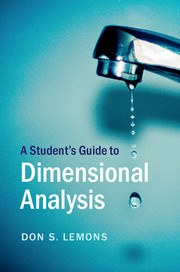References
1.Galilei, Galileo, Two New Sciences, translated by Crew, Henry and de Salvio, Alfonso, (Chicago, IL: Encyclopedia Britannica Inc., 1952), p. 187.
2.Huntley, H. E., Dimensional Analysis (Mineola, NY: Dover, 1967), p. 33.
3.Fourier, Joseph, The Analytical Theory of Heat, translated by Freeman, Alexander (Mineola, NY: Dover, 1878), Book II, Section IX, Articles 157–162. Fourier closes his discussion of dimensional analysis with the comment that, “On applying the preceding rule to the different equations and their transformations, it will be found that they are homogeneous with respect to each kind of unit, and that the dimension of every angular or exponential quantity is nothing. If this were not the case some error must have been committed in the analysis … .”
4.Rayleigh, Lord (Strutt, John William), The Principle of Similitude. Nature, March 18, (1915).
5.Buckingham, Edgar, On Physically Similar Systems; Ilustrations of the Use of Dimensional Equations. Physical Review, Vol. IV, no. 4, (1915), 345–376.
6.Langhaar, H. L. emphasizes this aspect of the theorem. See his Dimensional Analysis and Theory of Models (Hoboken, NJ: Wiley, 1951), p. 18.
7.Buckingham, Edgar, On Physically Similar Systems; Ilustrations of the Use of Dimensional Equations. Physical Review, Vol. IV, no. 4, (1915), 345–376.
8.This definition reformulates an equivalent one found in Van Driest, E. R., On Dimensional Analysis and the Presentation of Data in Fluid Flow Problems. J. Applied Mechanics, Vol. 13, no. 1, (1946) A–34. See also H. L. Langhaar, Dimensional Analysis and Theory of Models (Hoboken, NJ: Wiley, 1951), p. 29.
9.The number of effective dimensions is also the “rank of the dimensional matrix” – a mathematical concept exploited in fluid mechanics engineering texts. See, for instance, Fox, R. W., McDonald, A. T., and Pritchard, P. J., Fluid Mechanics (Hoboken, NJ: Wiley, 2004), pp. 282–283.
10.The concept, although not the name, of imposed dimension originates with Bridgman, Percy’s highly recommended text Dimensional Analysis (New Haven, CT: Yale University Press, 1922). See, in particular, pp. 9–11, 63–66, 67–69, and 77–78. Others, including H. E. Huntley, Dimensional Analysis, (Mineola, NY: Dover, 1967), use the concept of imposed dimensions.
11.Barenblatt, G. I., Scaling, Self-Similarity, and Intermediate Dynamics (Cambridge, UK: Cambridge University Press, 1996), pp. 18 ff.
12.Helmholtz, Hermann, On the Sensations of Tone 6th Edition (Gloucester, MA: Peter Smith, 1948), pp. 43–44.
13.Bridgman, Percy, Dimensional Analysis (New Haven, CT: Yale University Press, 1922), p. 107.
14.Taylor, G., The Formation of a Blast Wave by a Very Intense Explosion. II. The Atomic Explosion of 1945. Proceedings of the Royal Society of London. Series A, Mathematical and Physical Sciences, Vol. 201, No. 1065, (Mar. 22, 1950), 175–186.
15.Lindberg, David C., The Beginnings of Western Science (Chicago, IL: University of Chicago Press, 1992), p. 305.
16.See Aristotle, , The Basic Works of Aristotle editor McKeon, Richard, (New York, NY: Random House, 1966) Physics, Book IV, chapter 8, p. 216a, lines 14–17. See also David C. Lindberg, The Beginnings of Western Science (Chicago, IL: University of Chicago Press, 1992), pp. 59–60.
17.Godwin, R. P., The Hydraulic Jump (‘Shocks’ and Viscous Flow in the Kitchen Sink), American Journal of Physics 61 (9), (1993) 829–832.
18.Nansen, Fridtjof, Farthest North (Edinburgh, UK: Birlinn, 2002), p. 186.
20.Bridgman, Percy, Dimensional Analysis (New Haven, CT: Yale University Press, 1922), problem 19, p. 108.
21.Traditionally the “Boussinesq problem.” See Bridgman, Percy, Dimensional Analysis (New Haven, CT: Yale University Press, 1922), pp. 9–11.
22.Taylor, Lloyd W., Physics: The Pioneer Science (Mineola, NY: Dover, 1941), pp. 592–593.
23.Dunmore, John, Pacific Explorers: The Life of John Francois de La Perouse 1741–1788 (Palmerston North, NZ: The Dunmore Press Limited, 1985), pp. 286–292.
24.Schiff, L., Quantum Mechanics 3rd Edition (New York, NY: McGraw Hill, 1968) pp. 397 ff.
25.Planck, Max, Theory of Heat Radiation (Mineola, NY: Dover, 2011), pp. 205–206. Number 164.



